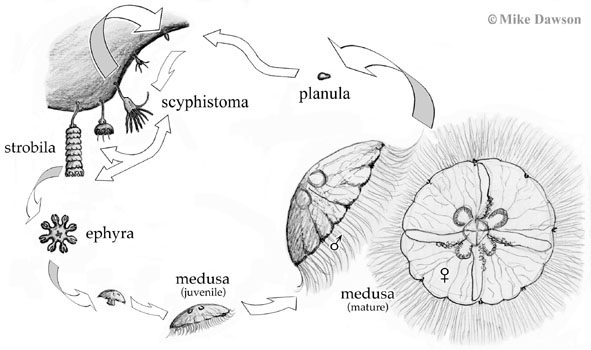Ecology
"The science of the economy of animals and plants; that branch of biology which deals with the relations of living organisms to their surroundings, their habits and modes of life, etc."
Modified from the Greek "oikos" meaning "house" or "dwelling" (Oxford English Dictionary).
Life Cycle
Most scyphozoan jellyfishes—including most of the large jellyfish with which many people are familiar—have a two part life cycle: free-swimming medusa and bottom-dwelling polyp (although there are notable exceptions such as with Stauromedusae). The free-swimming medusa (the part we call "a jellyfish") is either female or male and produces eggs or sperm which combine to produce a larva, called a 'planula' (plural = planulae). The planula swims through the water to find a suitable place to settle, i.e. attach itself to a surface. In the marine lakes, Mastigias planulae settle on the surface (typically the sides or underneath) of rocks, rotting logs, and decaying leaves that accumulate around the lake's side in the poorly oxygenated (but not anoxic) waters at intermediate depths. The planula metamorphoses into a sessile (i.e. fixed-position), usually benthic (i.e. bottom dwelling) polyp called a 'scyphistoma' and it is the scyphistoma, still attached to the surface on which the planula settled, that produces a new free-swimming medusa. The process by which new medusae are produced is called 'strobilation' and involves metamorphosis of the end of a scyphistoma into an 'ephyra', an immature medusa, that subsequently detaches and swims away. Depending on the species, a single polyp may produce one or many ephyrae all at once, over a period of time, or at different intervals. The ephyra subsequently develops into a mature medusa over a period of weeks to months.
Symbioses
There are two commonly used definitions of symbiosis (from the Greek syn = together, bio = life) which differ in biologically relevant ways that can be confusing if not clarified beforehand (Wilkinson 2001). The first definition is the more broad, encompassing all close long-term associations between different [species of] organisms (sensu de Bary 1879). The second is more specific, referring only to those close long-term associations that are beneficial to both, or all, of the organisms involved (e.g. Woodhead 1915, cited by Wilkinson 2001). Here, we follow the original definition, further classifying the type of symbiosis depending on whether the relationship has a net benefit or detriment to one or the other organism, as follows. (For simplicity, we represent symbioses as involving two organisms, although they may involve more.)
It is possible to define the relationships between symbiotic organisms further (Smith & Douglas 1987). For example, in any pair, the larger organism is the host and the smaller organism the symbiont. Ectosymbionts occur on the outside of the host. Endosymbionts occur inside the host and may be intracellular or extracellular. Symbiosis may be obligate, if an organism cannot survive and reproduce without its partner, or facultative. Symbioses also may differ in their specificity, from being highly specific (always involving the same strains or subspecific taxon) to very general (involving organisms within a class, phylum, or larger grouping). The symbiosis may also be classified according to the mode of interaction (e.g. genetic, metabolic, behavioral) and a donor and recipient identified for each resource.
Although predation could be defined as a kind of parasitism (the predator benefits to the detriment of the prey) and competition is an association that is detrimental to both organisms involved, they are not traditionally described as symbioses because they are not generally long-term associations (Smith & Douglas 1987), and in the case of competition also need not be close. Predation and competition, therefore, are discussed elsewhere.
Many symbioses can be found involving scyphozoans. Follow the links to mutualism, commensalism, and parasitism to find out more.
Prepared by M. N Dawson
Types of Symbioses
Mutualism (beneficial-beneficial):
Mutualisms are symbioses from which all organisms benefit. A common example of commensalism involves photosynthetic dinoflagellates, called zooxanthellae, and tropical jellyfish belonging to at least two orders, the Coronatae and Rhizostomeae. The microscopic zooxanthellae live within the tissues of the much larger jellyfish. The zooxanthellae convert sunlight and inorganic compounds (e.g. water, carbon, nitrogen) into energy rich organic molecules (carbohydrates) that they use to live and grow. However, some of these organic molecules also become available to the host jellyfish, so it benefits also. In turn, the jellyfish's metabolism produces inorganic molecules (e.g. ammonium) as waste products, some of which become available to the zooxanthellae. the zooxanthellae use the inorganic molecules to make more organics.
